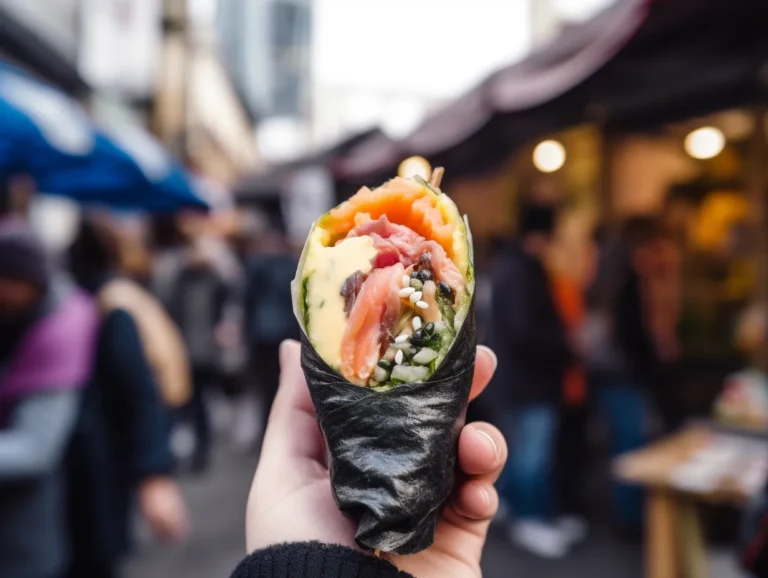Craving something bold, healthy, and utterly satisfying? Enter the sushi burrito—a jaw-dropping blend of your favorite sushi rolls and the convenience of a wrap. This guide dives deep into what a sushi burrito really is, how it differs from traditional sushi, and why it’s exploding in popularity across the globe. We’ll show you how to build your own, explore top U.S. spots like Kazu Sushi Burrito and Soho Sushi Burrito, and even break down the health perks (and pitfalls) of this trend. Plus, you’ll get insider tips, answers to burning questions like “Where can I find a sushi burrito near me?”, and more. Whether you’re a sushi pro or a newbie, you’ll find something delicious here.
What is a Sushi Burrito?
The Birth of the Sushi Burrito
The sushi burrito isn’t just a food—it’s a full-blown movement in the fusion cuisine world. Born in the heart of fast-casual dining in the early 2010s, this genius creation combines the art of sushi-making with the grab-and-go ease of a burrito. Think of it as a massive sushi roll, uncut, stuffed with fresh ingredients, and wrapped tightly in a nori sheet or soy paper for easy eating on the move.
Spearheaded by innovative restaurants in cities like San Francisco and New York, the sushi burrito quickly gained traction with foodies craving something familiar yet fresh. It’s no longer a coastal trend—thanks to the rise of Asian fusion spots like Soho Sushi Burrito and Kazu Sushi Burrito, this hand-held delight has gone mainstream.
How It Differs from Traditional Sushi and Burritos
At first glance, a sushi burrito may look like a sushi roll that had one too many protein shakes. But there’s more than size setting it apart. Unlike traditional sushi, which is delicate, bite-sized, and often served with ceremony, sushi burritos are bold, customizable, and made for busy hands and big appetites.
The fillings are far more diverse too. While classic sushi leans heavily on raw fish like sashimi, sushi burritos invite a medley—grilled shrimp, spicy tuna, tofu, avocado, pickled veggies, even tempura crunch. Wrapped in seaweed and packed like a burrito, it’s a foodie’s dream come true.
And unlike a traditional burrito, there’s no tortilla or beans here. Instead, sushi rice (or alternatives like cauliflower rice or brown rice) takes center stage, with Asian-inspired sauces like spicy mayo, eel sauce, and ponzu tying it all together. Simply put, it’s a portable poke bowl with swagger.
Inside the Sushi Burrito: Common Ingredients & Customizations
Popular Fillings: From Raw Fish to Tofu
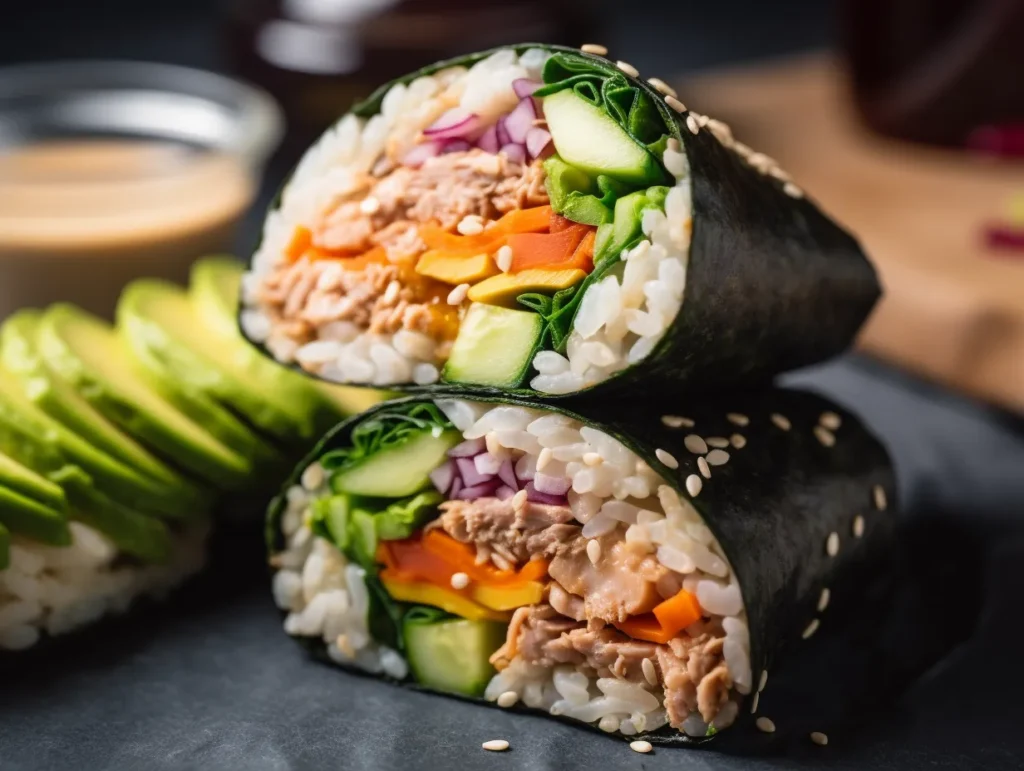
A sushi burrito is only as good as what’s inside it—and that’s where things get exciting. This isn’t your average roll. These giant wraps can include everything from classic spicy tuna and salmon sashimi to bold fillings like crispy shrimp tempura, grilled chicken, or even tofu for a plant-based punch.
Thanks to its Asian fusion roots, flavor is front and center. Expect creamy avocado, crunchy cucumbers, and colorful pickled veggies like daikon and carrots. Sauces play a starring role too—spicy mayo, soy glaze, sriracha aioli, and ponzu add depth and zing to every bite.
One popular twist? Crunchy toppings. Think fried shallots, puffed rice, or wonton strips—all adding texture that rivals even the best poke bowls.
Sushi Rice vs. Brown Rice vs. Cauliflower Rice
Your wrap base sets the tone for the whole burrito. Traditional sushi rice offers that sticky, slightly tangy taste most people expect. But if you’re watching carbs or prefer a nuttier flavor, brown rice or even cauliflower rice can shake things up.
Many sushi burrito spots now offer these alternatives to match modern diets—especially for those leaning gluten-free, keto, or vegan. Some even allow a mix of rice and leafy greens for an ultra-light wrap.
And hey, if you love unique wraps, you might enjoy this healthy tuna salad wrap with Greek yogurt dressing, which follows the same build-your-own concept in a fresher way.
Vegan, Gluten-Free, and Keto-Friendly Variations
Good news! Sushi burritos are super customizable. Vegan options usually feature tofu, mushrooms, and loads of crunchy veggies, while gluten-free versions skip soy sauce in favor of tamari or coconut aminos. Want keto? Just swap rice for cauliflower or skip it altogether for a seaweed wrap.
Whether you’re craving flavor-packed carbs or a light, veggie-forward wrap, there’s a sushi burrito out there waiting to fit your lifestyle. And guess what? You don’t have to give up bold, umami-packed flavor to eat clean.
How to Make a Sushi Burrito at Home
Essential Tools and Ingredients for Sushi Burrito Making
Making a sushi burrito at home might sound intimidating, but with the right tools and a little prep, it’s surprisingly easy—and super fun. Here’s what you’ll need:
- Bamboo sushi mat (or plastic wrap and a towel will do)
- Sharp knife
- Nori sheets (seaweed)
- Sushi rice (or brown rice, cauliflower rice)
- Fresh fillings like spicy tuna, avocado, cucumbers, carrots, tofu
- Sauces: spicy mayo, eel sauce, soy sauce, ponzu
You can grab most of these at an Asian market or even the international aisle at a local grocery store. Just don’t skip the nori—it’s what makes a sushi burrito, well, a sushi burrito.
Step-by-Step Recipe with Pro Tips

Ready to roll? Let’s do this:
- Cook your rice with rice vinegar, sugar, and salt for that signature sushi flavor.
- Lay out your nori on a flat surface or bamboo mat.
- Spread rice evenly, leaving a 1-inch border at the top to help it seal.
- Layer your fillings—protein first, then veggies, then drizzle with sauce.
- Roll tightly, using your fingers to keep the shape firm.
- Seal with water, slice in half if you’d like, and voilà—homemade sushi burrito magic.
Pro tip: Keep your hands damp to prevent rice from sticking while rolling!
Want to experiment? Try different proteins, sauces, or even swap in a soy paper wrap. That’s the beauty of it—your kitchen, your rules.
Common Mistakes to Avoid for First-Time Makers
It’s easy to get a little too excited and overstuff your wrap. Don’t. A packed sushi burrito might sound dreamy, but if it’s bursting at the seams, rolling becomes a nightmare.
Also, avoid using wet veggies like tomatoes or iceberg lettuce—they’ll sog out your nori. Instead, go for firm, crunchy choices like carrots, cucumbers, or cabbage.
Lastly, don’t skip the rice seasoning. Bland rice = bland burrito. And nobody wants that.
Best Sushi Burrito Places in the U.S.
Spotlight: Kazu Sushi Burrito – What Makes It Special?

If there’s one name that’s become synonymous with the rise of the sushi burrito in America, it’s Kazu Sushi Burrito. With locations across Florida, Kazu has mastered the fast-casual sushi game by offering a vibrant selection of customizable wraps that blend Japanese precision with American-sized portions.
Their menu boasts crowd-pleasers like spicy tuna crunch and salmon lovers, but they also cater to every diet, offering tofu options and low-carb wraps. What really sets Kazu apart? It’s their balance—premium ingredients, speedy service, and fun combinations you won’t find at a traditional sushi bar.
Soho Sushi Burrito: Urban Twist on the Trend
Meanwhile, over on the West Coast and in Las Vegas, Soho Sushi Burrito brings serious flair. These sushi burritos are bold, colorful, and Instagram-worthy. You can build your own or pick from house specials like “Soho Firecracker” or “Dragon Roll Supreme”—wrapped up in nori and bursting with flavor.
Soho’s success lies in their creativity. They’re not afraid to mix Korean BBQ beef with kimchi, or top a burrito with fried jalapeños. This is street food with style.
Finding a Sushi Burrito Near Me – Local Spot Tips
If you’re thinking, “Where can I find a sushi burrito near me?”, you’re not alone. More fusion-focused eateries and poke shops now include sushi burritos on their menus. Use apps like Yelp or Google Maps, and search for local Asian fusion spots, poke bowl counters, or Japanese cafes. Look for places with terms like hand rolls, sashimi wraps, or custom sushi—they’re often hidden gems.
Health Benefits & Nutritional Considerations
Is a Sushi Burrito Healthy?
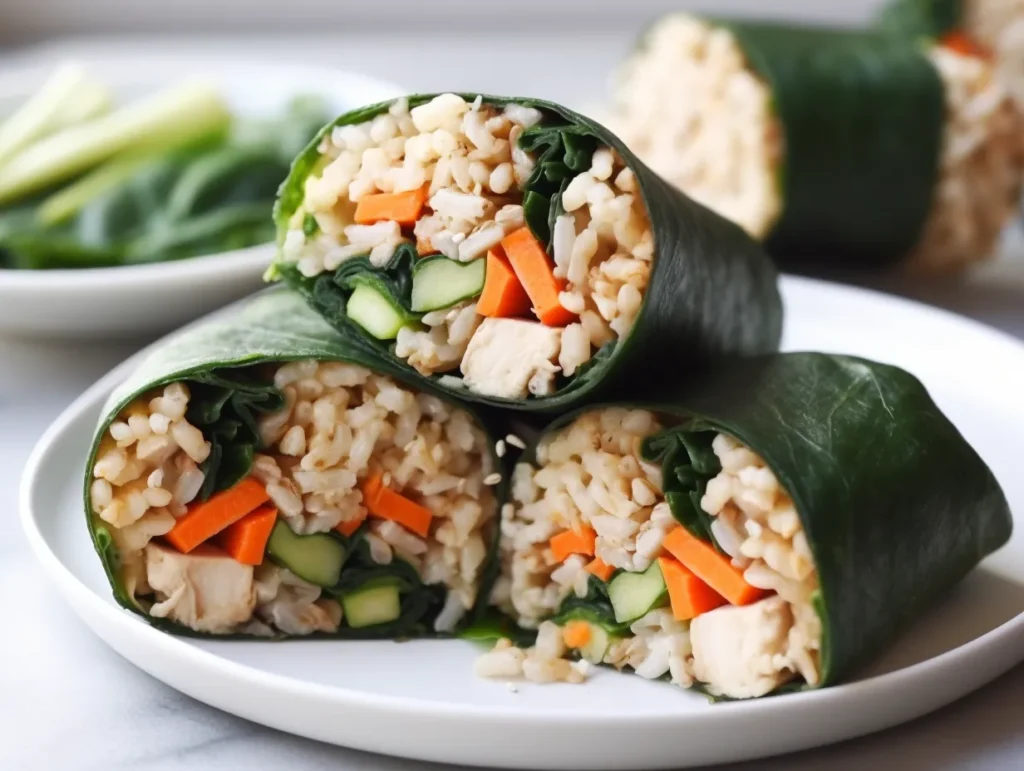
The big question: Is a sushi burrito actually good for you? Well, it can be—if you build it right. These wraps often feature high-quality proteins like salmon, tuna, or tofu, which are loaded with omega-3 fatty acids and lean protein. Add in crisp vegetables, seaweed, and fermented ingredients like pickled radish, and you’re getting a dose of fiber and gut-friendly goodness.
Plus, compared to many fast food meals, a well-made sushi burrito skips deep-frying and heavy oils, making it a cleaner, more balanced option.
What to Watch Out For: Sodium, Mercury, and Calories
That said, not all sushi burritos are created equal. Some are sneaky calorie bombs, especially those packed with creamy sauces, fried ingredients, or extra rice. A single wrap can range from 400 to 900+ calories—so portion control matters.
Also, be mindful of sodium. Soy sauce-based marinades and dressings can quickly raise your salt intake. Ask for light sauce or get it on the side if you’re watching your blood pressure.
And if you’re eating sushi burritos regularly, consider the mercury content in raw fish like tuna. Rotating between fish, tofu, and veggie options is a smart move for overall balance.
Sushi Burrito vs. Poke Bowl vs. Sushi Roll
Texture, Portability, and Flavor Comparison
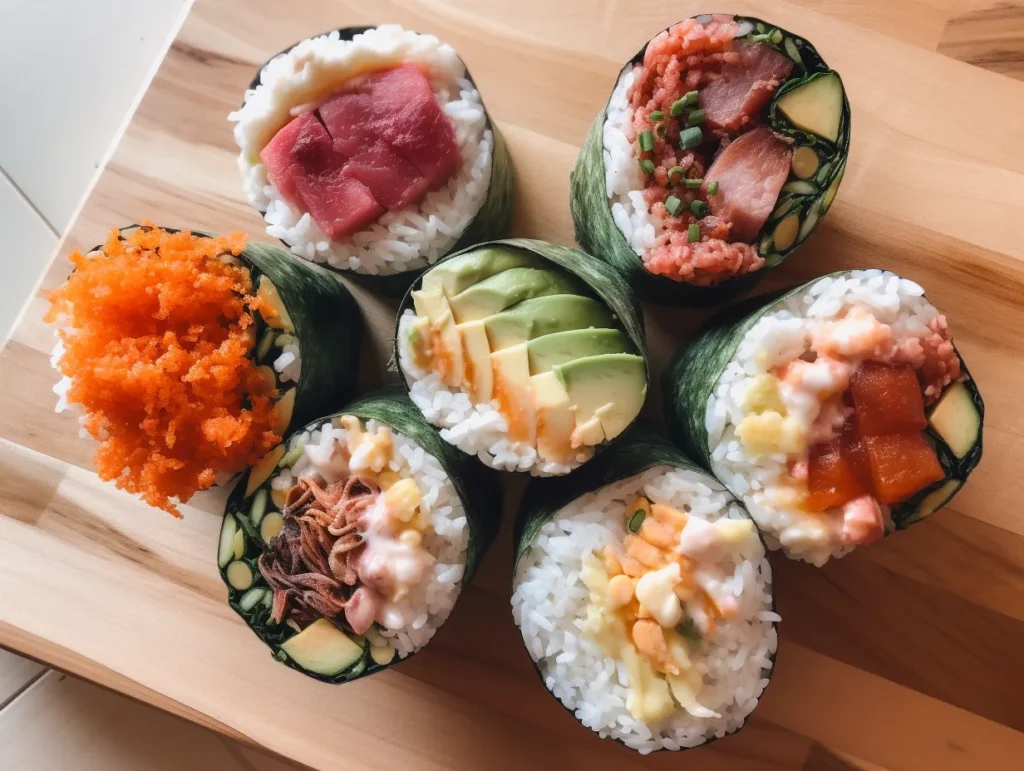
Let’s face it—sushi burrito, poke bowl, and sushi roll are all delicious, but each brings something different to the table. If you’re looking for texture, the sushi burrito wins big. Wrapped in a crisp sheet of nori and loaded with crunchy veggies, creamy avocado, and tender fish, it offers a bite that’s bold and satisfying.
Meanwhile, poke bowls bring variety in a bowl, giving you all the flavors of sushi without the wrap. They’re spoonable and perfect for leisurely meals. Sushi rolls, the OG of the trio, are all about precision—bite-sized, elegant, and dipped in soy sauce with chopsticks.
But here’s the kicker—sushi burritos are the only ones you can truly eat on the go. No utensils. No fuss. Just unwrap and enjoy wherever you are.
Which is More Customizable?
All three options are super flexible, but sushi burritos offer more space for creativity. You can stuff them with grilled chicken, tempura shrimp, tofu, or even mix cooked and raw ingredients. Plus, with all that surface area, there’s room for extra toppings, sauces, and even crunchy textures that don’t fit well in tight sushi rolls.
Poke bowls are close runners-up when it comes to variety, letting you build your own base and layer toppings like crazy. But if you’re the type who wants your meal rolled up tight with your signature flavor twist, the sushi burrito is your best bet.
FAQs About Sushi Burritos
Is a sushi burrito raw?
Not always! While many sushi burritos feature raw fish like spicy tuna or salmon, there are tons of options with cooked proteins. Think grilled shrimp, crab, even tempura chicken. Plus, vegetarian and vegan versions ditch the fish altogether in favor of tofu or mushrooms. So, whether you’re sushi-savvy or cautious about raw seafood, there’s a burrito for you.
Can I find sushi burritos near me?
Yes—and probably closer than you think! Search for local Asian fusion spots, poke shops, or fast-casual sushi restaurants. Chains like Kazu Sushi Burrito and Soho Sushi Burrito have made waves across major U.S. cities. Apps like Yelp and Google Maps are your best friend for locating the nearest roll-and-go gem.
What’s the best fish for sushi burritos?
The top picks? Tuna, salmon, yellowtail, and even eel. These fish offer rich flavors and the right texture to hold up in a burrito-sized portion. Just make sure it’s sushi-grade if you’re making it at home—safety first!
How long does a sushi burrito stay fresh?
A freshly made sushi burrito is best eaten right away. If you must store it, wrap it tightly and refrigerate it—but don’t wait more than 24 hours. The rice can harden and the seaweed wrap may lose its texture. Plus, raw fish should always be handled with care.
People Also Ask – Common Questions About Sushi Burritos
Is a sushi burrito better than sushi?
That depends on what you’re looking for! A sushi burrito is basically a giant, uncut sushi roll—wrapped tight and loaded with fillings. It’s more portable, often more filling, and easier to customize. On the flip side, traditional sushi is usually more delicate, precise, and ideal for a sit-down experience. If you want fast and flavorful, go burrito. If you’re after elegance and smaller bites, sushi might be your jam.
How many calories are in a sushi burrito?
Calorie counts vary depending on ingredients, but most sushi burritos range from 400 to 900 calories. Want to lighten it up? Go for brown or cauliflower rice, skip the heavy sauces, and load up on veggies. Want something hearty? Add tempura shrimp, spicy mayo, or avocado. As always, balance is key.
What is the difference between a sushi burrito and a poke bowl?
Here’s the scoop: poke bowls and sushi burritos often share the same ingredients—like raw fish, rice, veggies, and sauces. The difference is in how they’re served. Poke bowls are eaten with a spoon or chopsticks, while sushi burritos are hand-held, rolled, and ready to go. If you’re all about convenience and zero cleanup, the burrito wins hands down.
Can I make a sushi burrito at home without raw fish?
Absolutely! You don’t need raw fish to make a tasty sushi burrito. Tofu, grilled chicken, shrimp tempura, or even roasted veggies make excellent alternatives. Add in your favorite sauces and you’ve got a wrap that’s every bit as delicious—no raw ingredients required.
Conclusion – Final Thoughts on the Sushi Burrito
From street food trucks to big-city fusion joints, the sushi burrito has carved out its spot in modern food culture—and it’s not going anywhere anytime soon. With its bold flavors, diverse textures, and endless room for creativity, this hand-held fusion is more than just a trend; it’s a satisfying and flexible meal you can grab on the go or craft in your own kitchen.
Whether you’re a sushi purist or a fusion foodie, there’s no denying the charm of this rolled-up powerhouse. It combines the best parts of sushi, burritos, and poke bowls—all in one neat, seaweed-wrapped package.
So the next time you’re thinking, “Where can I get a sushi burrito near me?”—remember, your next favorite bite might be just down the street… or in your own kitchen.
Print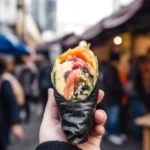
Sushi Burrito
- Total Time: 15 minutes
- Yield: 2 servings 1x
- Diet: Gluten Free
Description
This sushi burrito recipe is a bold, hand-held fusion of classic Japanese sushi and modern street food. Packed with sushi-grade fish, fresh vegetables, and flavorful sauces, it’s a customizable, on-the-go favorite.
Ingredients
-
1 cup sushi rice, cooked and seasoned
-
2 sheets nori (seaweed)
-
4 oz sushi-grade tuna or salmon
-
1/2 avocado, sliced
-
1/4 cup julienned carrots
-
1/4 cup cucumber strips
-
1 tbsp spicy mayo
-
1 tsp sesame seeds
-
Optional: pickled ginger, soy sauce, or tamari
Instructions
Lay out nori on a bamboo mat.
Spread an even layer of sushi rice, leaving a 1-inch gap at the top.
Layer tuna, avocado, carrot, cucumber, and spicy mayo in the center.
Roll tightly using the mat, sealing the edge with water.
Slice in half and sprinkle with sesame seeds.
Serve with soy sauce or dipping of choice.
Notes
Use brown rice or cauliflower rice for low-carb versions.
Add tofu or tempura shrimp for protein alternatives.
- Prep Time: 15 minutes
- Cook Time: 0 minutes
- Category: Lunch
- Method: Rolling
- Cuisine: Asian Fusion
Nutrition
- Calories: 420 kcal
- Sugar: 4 g
- Sodium: 620 mg
- Fat: 18 g
- Saturated Fat: 4g
- Carbohydrates: 45 g
- Fiber: 6 g
- Protein: 22 g
- Cholesterol: 30 mg
Keywords: sushi burrito, sushi wrap, Asian fusion, poke burrito, sushi roll burrito

